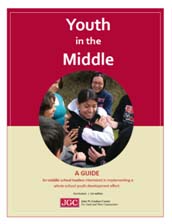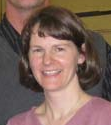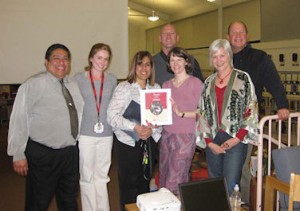by Patreece Thompson
Patreece: Thank you so much Christina for the opportunity to speak with you about Youth in the Middle, (YiM) a pilot program that seeks to address youth development from holistic and systemic perspectives. We would like to learn a little about you. What inspired you to become involved with the YiM Program?
Christina: I was a former teacher for the 5th and 6th grades. Then I obtained my Masters in Education in Instructional Technology and curriculum design and later was involved as a program manager for NASA and The Tech Museum in STEM education – (STEM is an acronym for “Science, Technology, Engineering and Mathematics”).
I became interested in schools and reform. Through my network, I became connected with YiM because I wanted to be: a. more in touch with school reform, b. in touch with schools that are doing the work of reform, c. in situations to think about school as a system.
Patreece: As I understand it, this program started as a conversation between John W. Gardner former, Secretary of HEW during LBJ administration, and Dr. Milbrey McLaughlin, professor of education and public policy. What is a community school? How did Kennedy School come to be chosen for this “pilot”?
Christina: John W. Gardner was not involved in starting Youth in the Middle. He was a close friend of Dr. Milbrey’s (founder of the John W. Gardner Center for Youth and Our Community) and he allowed her to start the center in his name because our general work around community youth development is aligned with his philosophy of working with community to support young people who then give back to community.
A community school is one that “belongs to the community”. It has an on-site Family Resource Center which assesses families’ eligibility for and provides access to county social services, family and youth counseling services, parent leadership classes, and comprehensive after-school programs through partnerships with community agencies.
The school is open extended hours and during vacations so the community can use it.
By definition then, community schools are concerned about the whole child – intellectually, mentally, physically and socially. Three years ago when the pilot was started in the Redwood City School District (RCSD), people realized that that although youth development took place during the school hours, the perception was that “youth development” happened after school. How could the concept of Youth in the Middle, with youth holistic needs at the center, occur throughout the school day?
Kennedy, as a community middle school was selected to start those conversations.
During the 2008-2009 school year at Kennedy Middle School, 73% of the students were identified by their families as Hispanic, 16% as white, and 11% as African-American, Asian, and Filipino. In the same year, 38% of Kennedy’s students were identified as English Language Learners and 66% participated in the free and reduced lunch program.
The focus is on middle school because it was felt there was more need to help youth in that age group. With the elementary school age group, the teachers had time to bond with the children and really get to know them. They stayed with the students all day long. Teachers of that age group had a better understanding of child development.
However, young adolescence is a time of transition – students go to a new school. They are not able to form those bonds with teachers, and they need much more support. This was a niche area that needed attention. People tended to avoid involvement with students in grades 6-8 on the level that occurs with earlier grades.
Patreece: Does the designation of community school make this program’s success more possible than in a public/private/charter school and if so in what way? Must the school be a community school or can it be K-8?
Christina: This is a developing program for all middle schools. We have no experience with non-community schools. The YiM Guide is not prescriptive. A school can decide what areas to work on; there are rubrics for the different components.
 Patreece: What is it about this venture between the Kennedy school and the JGC that you found really works?
Patreece: What is it about this venture between the Kennedy school and the JGC that you found really works?
Christina: The structure of the four work areas really provide the components that are important for success. The YiM Guide introduction provides a more detailed overview.
1. Engage Cross Functional Expertise in Support of Youth
Bring all constituents together: youth, parents, teachers, administrators, counselors, community partners (representatives of these groups) to envision full development for young people. This area addresses the question of how to make the process safe and equitable for all participants.
2. Situate Academic Learning and Achievement in the Context of a Youth Development Approach
This is a difficult area because of the approach. What happens initially is that conversations become either/or – either academics or youth development are to be the focus for reform. The approach is to shift the conversation to both/and. At the heart of schools is certainly academic achievement and in order to be successful academically, there needs to be support for students’ emotional, physical, and social aspects.
The task at this stage is to help educators with what they know to be true. Educators learn about youth development and its connection with learning. Youth development pertains to all kids, not just the ones at risk. We need to see youth who are leaders and contributing to society. Focus on the positives, and do it intentionally and systemically
3. Integrate Local and Research Knowledge
This work area helps participants to understand principles behind research and be able to adapt them to their local particular situation. What is provided is research background around youth development as well as a workshop format to follow.
4. Create Conditions and Habits for Shared Responsibility
This area is only about a year old and is more recent. It recognizes that because the model is based on the input of constituents and is not hierarchical, everyone must learn how they can be responsible for carrying out the vision. There needs to be skill building to foster the concept.
Patreece: The name “Youth in the Middle” – does it refer to youth in middle school and/or youth in the center of visioning, planning?
Christina: Yes – it’s a double entendre.
Patreece: As I was scanning the guide which has rich material, I came across one of the aspects of culture that the program wanted to create – “No such thing as smart or dumb”. How did that show up in creating a motivating culture that emerged at Kennedy?
Christina: This is a work in progress. We refer to the work of Dr. Carol Dweck [Standford psychologist who studied the origins of self-concept and its role in motivation and impact on achievement]. She compared the “growth mindset” that could be changed through effort vs. “fixed mindset” achieved by looking smart and not risking learning in order to avoid looking “stupid”.
Patreece: Are there early signs of accomplishing the vision of Gardner-McLaughlin et al in creating authentic youth development for middle school children?
Christina: We see early signs of success in individuals with ‘aha’ moments. For example, a teacher was excited by the finding that 75% of kids are motivated by their families.
We are noticing shifts in thinking about other school members and how they talk about each other. The changes are relational/interactional at this point.
Also we did have some measurable results: there is a 2/3rd reduction in suspensions in the second year compared to the first year of the program.
The John Gardner Center is now surveying 2500 children with a youth developmental survey in the Redwood City School District . It is inquiring into student beliefs in academic achievement, how they feel about their capability and the practices their teachers use: practices that reinforce learning for sake of learning or practices that focus on performance-based learning leading to a more fixed mind set.
The researchers are finding when teachers use learning for the sake of learning children believe in their capabilities and perform better academically. This finding spans race, gender and culture.
Patreece: I really appreciate your providing us with wonderful concepts to build upon with youth in the middle.
We encourage everyone to learn more about this program by visiting the Youth in The Middle Guide on the John Gardner Center website.

